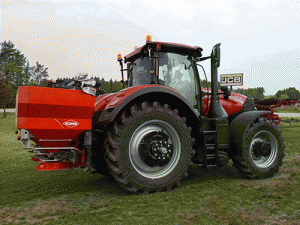Go slower, spray more
AGRONOMIC INFORMATION FROM ONTARIO'S CROP SPECIALISTS

IN AN EFFORT to get more done in a day, and to ensure sprays are applied during an ever-shrinking window of opportunity, sprayer operators may be tempted to drive faster. Certainly, sprayer manufacturers have supported this strategy by making self-propelled sprayers capable of high speeds. However, just because you can drive 25 mph doesn’t mean you should.
Driving faster encourages higher booms (to combat accidental impacts) but that leads to increased pesticide drift and reduced control over canopy deposition. It would seem the operator has to choose between getting enough done in a day, and the quality of the application — but what if you could have your cake and eat it too?
Dr. Tom Wolf, application technology scientist at Agrimetrix, spent the last year working on that question, and it led him to develop a deceptively simple Productivity Calculator (http://sprayers101.com/productivity-calculator/). The model makes a few assumptions that allow the user to determine the productivity impact of each element of a typical spray day.
What the calculator shows is that driving faster is the equivalent of “a race car in stop-and-go traffic”; it doesn’t create the productivity boost the operator hopes for because too much time is lost in turns and refills. In fact, the time actually spent spraying versus logged engine hours is usually less than 50% depending on the operation. Idling isn’t just lost time, it’s also expensive when you consider the depreciation that can accumulate over 20 or 50 extra engine hours per year, valued at between $100 to $300 per hour. What that suggests is that it’s the down time, and not travel speed, that should be addressed. As Wolf says, “in spraying, the race is won in the pits”.
The calculator shows that two of the factors with the biggest impact on productivity are loading and cleaning, and these are also the easiest to improve. Loading time can be reduced by moving to a three inch diameter fill line and higher-capacity pump, coupled with a product inductor (vs a product pump, which can become the limiting factor) with attention to ensuring products are still properly mixed and hydrated.
Sprayer operators volunteered a range of suggestions for making the filling process more efficient in this article: http://sprayers 101.com/sprayer-nurse-truck-designs/. A well designed tender system can mix and fill a 1,200 gal sprayer tank in 10 minutes, sometimes less.
Some manner of sprayer clean-out is a daily necessity. The level to which the operator rinses or decontaminates the sprayer (and the time required) depends on a lot of factors. New techniques such as continuous rinsing (http://sprayers101.com/ continuous-rinsing-should-be-considered-in-north-america/) have the conservative potential to reduce the time required by half. Eliminating dead-end plumbing (e.g. installing air-aspirating boom section ends) and reducing the volume of left-over spray mix (e.g. better math and installing more accurate filling sensors) helps to ensure the process is just as effective as a classic triple-rinse.
In fact, by reducing the time needed to fill and clean, the calculator shows the operator can drive slower and still be more productive. And if the operator slows down, there’s an opportunity to reduce the number of headlands from two to one (because the sprayer can slow to turning speed more readily) and to consider longer booms (because slower speeds means less sway, and wider booms mean fewer passes and turns). The collective impact is even more acres sprayed.
And so, operators are encouraged to consider the spray day holistically — not just the time spent spraying, but all the activities required from start to finish. Ultimately, by making component tasks more efficient, the operator is rewarded with an improved spray job in fewer hours.
Experiment with the Productivity Calculator to determine your best configuration. You can find it and lots of other sprayer-related resources on www.sprayers101.com.
Dr. Tom Wolf, is the application technology scientist at Agrimetrix. He can be found on Twitter @nozzle_guy. Dr. Jason Deveau is the application technology specialist with the Ontario Ministry of Agriculture, Food and Rural Affairs. He can be found on Twitter @spray_guy. They recently spoke on the subject of sprayer productivity at the 24th SouthWest Ag Conference in Ridgetown, Ontario. •

























